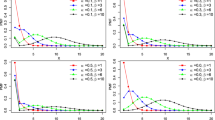Abstract
Hybrid censoring schemes are commonly used in life-testing experiments to reduce the experimental time and the cost. A Type-II progressive hybrid censoring scheme (PHCS) was introduced by Kundu and Joarder (Comput Stat Data Anal 50:2509–2528, 2006) that combines progressive Type-II censoring and Type-I censoring. In this paper, we consider the statistical inference of a two-parameter exponential distribution under the Type-II PHCS. The conditional maximum likelihood estimates (MLEs) of the model parameters and their joint and marginal conditional moment generating functions are derived. Based on these exact conditional moments, bias-reduced estimators are proposed and their distributions are discussed. Confidence intervals of the model parameters based on exact and asymptotic distributions of the MLEs and bias-reduced estimators are developed. The performances of the point and interval estimation procedures are evaluated and compared through exact calculations and Monte Carlo simulations. Recommendations are made based on these results and an illustrative example is presented.
Similar content being viewed by others
References
Bain LJ, Engelhardt M (1973) Interval estimation for the two-parameter double exponential distribution. Technometrics 15:875–887
Balakrishnan N (2007) Progressive censoring methodology: an appraisal. TEST 16:211–296 (with Discussions)
Balakrishnan N, Aggarwala R (2000) Progressive censoring: theory, methods, and applications. Birkhäuser, Boston
Balakrishnan N, Basu AP (1995) The exponential distribution: theory, methods and applications. Gordon and Breach, Newark, NJ
Balakrishnan N, Childs A, Chandrasekar B (2002) An efficient computational method for moments of order statistics under progressive censoring. Stat Probab Lett 60:359–365
Balakrishnan N, Cramer E (2014) The art of progressive censoring: applications to reliability and quality. Birkhäuser, New York
Balakrishnan N, Cramer E, Iliopoulos G (2014) On the method of pivoting the CDF for exact confidence intervals with illustration for exponential mean under life-test with time constraints. Stat Probab Lett 89:124–130
Balakrishnan N, Kundu D (2013) Hybrid censoring: models, inferential results and applications. Comput Stat Data Anal 57:166–209
Chen S, Bhattacharyya GK (1988) Exact confidence bounds for an exponential parameter under hybrid censoring. Commun Stat Theory Methods 17:1857–1870
Childs A, Chandrasekar B, Balakrishnan N, Kundu D (2003) Exact likelihood inference based on Type-I and Type-II hybrid censored samples from the exponential distribution. Ann Inst Stat Math 55:319–330
Childs A, Chandrasekar B, Balakrishnan N (2008) Exact likelihood inference for an exponential parameter under progressive hybrid censoring schemes. In: Vonta F, Nikulin M, Limnios N, Huber-Carol C (eds) Statistical models and methods for biomedical and technical systems. Birhäuser, Boston, pp 323–334
Childs A, Balakrishnan N, Chandrasekar B (2012) Exact distribution of the MLEs of the parameters and of the quantiles of two-parameter exponential distribution under hybrid censoring. Statistics 46:441–458
Cohen AC (1963) Progressively censored samples in life testing. Technometrics 5:327–329
Cohen AC (1966) Life testing and early failure. Technometrics 8:539–549
Cramer E, Balakrishnan N (2013) On some exact distributional results based on Type-I progressively hybrid censored data from exponential distributions. Stat Methodol 10:128–150
Epstein B (1954) Truncated life-test in exponential case. Ann Math Stat 25:555–564
Ganguly A, Mitra S, Samanta D, Kundu D (2012) Exact inference for the two-parameter exponential distribution under Type-II hybrid censoring. J Stat Plan Inference 142:613–625
Iliopoulos G (2015) On exact confidence intervals in a competing risks model with generalized hybrid type-I censored exponential data. J Stat Comput Simul. doi:10.1080/00949655.2014.945931
Johnson NL, Kotz S, Balakrishnan N (1994) Continuous univariate distributions, vol 1, 2nd edn. Wiley, New York
Kundu D, Joarder A (2006) Analysis of Type-II progressively hybrid censored data. Comput Stat Data Anal 50:2509–2528
MIL-STD-781-C (1977) Reliability design qualification and production acceptance tests: exponential distribution. U.S. Government Printing Office, Washington, DC
Montanari GC, Cacciari M (1988) Progressively-censored aging tests on XLPE-insulated cable models. IEEE Trans Electr Insul 23:365–372
Meeker WQ, Escobar LA (1998) Statistical methods for reliability data. Wiley, New York
R Core Team (2013) R: a language and environment for statistical computing. R Foundation for Statistical Computing, Vienna, Austria. http://www.R-project.org/
Thomas DR, Wilson WM (1972) Linear order statistic estimation for the two-parameter Weibull and extreme value distributions from Type-II progressively censored samples. Technometrics 14:679–691
Acknowledgments
The authors are grateful to the editor and the anonymous reviewer for their constructive comments which led to this substantial improvement on an earlier version of the paper. This project was supported by The Chinese University of Hong Kong Faculty of Science Direct Grant (Project ID 4053023) and a Grant from the Simons Foundation (#280601 to Tony Ng).
Author information
Authors and Affiliations
Corresponding author
Appendix: Proof of Theorem 1
Appendix: Proof of Theorem 1
The explicit expression of the conditional mgf of \({\hat{\theta }}\) and \({\hat{\mu }}\) can be derived by using the following lemmas.
Lemma 1
and
Proof
See Lemma 1 in Balakrishnan et al. (2002). \(\square \)
Lemma 2
\(p_{l}\) and \(T^*_{l}\) are defined by (7). \(\square \)
Proof
By using Lemma 1, we have
where \(a_1 = \frac{1+R_1}{\theta }+\frac{R^*_1t}{m}-s, a_i = \left( \frac{1}{\theta }-\frac{t}{m}\right) (1+R_i), \text{ for } 2\le i\le m.\) For \(j=1\), we have
and for \(j \ge 2\), we have \( \sum \nolimits _{i=j}^{m}a_i = \left( \frac{1}{\theta }-\frac{t}{m} \right) \sum \nolimits _{i=j}^{m}(1+R_i) =\left( \frac{1}{\theta }-\frac{t}{m} \right) R_{j-1}^*.\) Thus,
Then, we can write
\(\square \)
Lemma 3
\(p_{j,l}\) and \(T^*_{j,l}\) are defined by (8). \(\square \)
Proof
By using Lemma 1, we have

where \(a_1 = \frac{1+R_1}{\theta }+\frac{R^*_1t}{j}-s, a_i = \left( \frac{1}{\theta }-\frac{t}{j} \right) (1+R_i), \text{ for } 2\le i\le j. \) For \(j'=1\), we have \( \sum \nolimits _{i=1}^{j}a_i = \frac{1}{\theta }(n-R_{j}^*)+\frac{R_{j}^*t}{j}-s\), and for \(j'\ge 2\), we have \(\sum \nolimits _{i=j'}^{j}a_i = \left( \frac{1}{\theta }-\frac{t}{j} \right) (R_{j'-1}^*-R_{j}^*).\) Thus,
Therefore,
\(\square \)
Proof of Theorem 1
Condition on the values of \(D\) according to the different situations in Eq. (3), we have
Upon carrying out the integrations in the Eq. (30) by using Lemmas 2 and 3, we obtain the formula in Eq. (6) and hence Theorem 1 is proved. \(\square \)
Rights and permissions
About this article
Cite this article
Chan, P.S., Ng, H.K.T. & Su, F. Exact likelihood inference for the two-parameter exponential distribution under Type-II progressively hybrid censoring. Metrika 78, 747–770 (2015). https://doi.org/10.1007/s00184-014-0525-5
Received:
Published:
Issue Date:
DOI: https://doi.org/10.1007/s00184-014-0525-5




